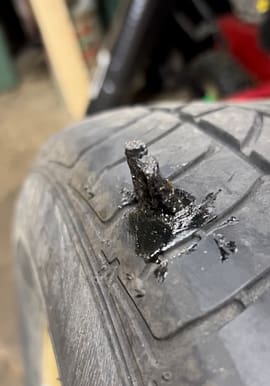How to Patch Tire (Plug Kit): Step-by-Step Instructions
Difficulty: Beginner
Estimated time: 30 minutes

Tools/Supplies Needed
- Gloves (recommended)
- Jack stands
- Floor Jack (or emergency jack provided with vehicle)
- Metric Socket Set and Wrench (or Tire Iron)
- Spray Bottle with soapy water (or Leak Detector)
- Scissors
- Plug Patch Kit
Here are the basic steps to follow:
Step 1: Ensure Safety
Before you begin the tire repair process, safety should be your top priority. Find a safe and level location to perform the repairs, preferably, away from traffic. Engage the parking brake and place wheel chocks behind the wheels to prevent any accidental rolling. You will also want to wear protective gloves and eye goggles throughout the job.
Step 2: Locate the Puncture
Inspect the tire to identify the puncture location. Look for any visible objects like nails, screws, or sharp debris. Sometimes, the culprit might be difficult to spot, and you might need to inflate the tire slightly to locate the leak. Applying a mixture of soap and water to the tire’s surface can help reveal any air bubbles indicative of a leak. You can also use a leak detector solution here as well.
Step 3: Deflate the Tire
Using a valve stem tool or the back end of a tire gauge to deflate the tire completely. This step is essential to ensure the plug will fit securely into the puncture site.
Step 4: Prepare the Plug Kit
Gather the necessary tools for tire repair, including a plug kit, rubber cement, and a tire plug insertion tool. A plug kit typically consists of tire plugs, which are thin, flexible strips made of rubber or synthetic material. These plugs effectively seal the puncture and prevent further air leakage.

Step 5: Insert the Plug
Take a tire plug from the kit and apply a thin layer of rubber cement to its surface. This step enhances the seal and provides additional adhesion. Insert the plug into the puncture hole using a tire plug insertion tool, ensuring it goes all the way in. Leave a small portion of the plug exposed, as this will be trimmed later.

Step 6: Trim Excess Plug
Using a utility knife or sharp scissors, carefully trim the exposed portion of the plug flush with the tire’s surface. Ensure a clean and neat finish, allowing the plug to sit evenly with the tire. Be cautious not to cut into the tire itself.

Step 7: Inflate the Tire
With the plug securely in place, it’s time to re-inflate the tire. Attach an air compressor or use a portable tire inflator to pump air into the tire. Monitor the tire pressure using a tire pressure gauge, ensuring it matches the manufacturer’s recommended PSI.
Step 8: Inspect and Monitor
Once the tire is fully inflated, inspect the repaired area to ensure a proper seal. Apply a mixture of soapy water to the patched area and observe for any visible bubbles that could indicate air leakage. If you have any leak detector, you can use that as well, which makes it even easier to detect than the soapy water, but it is really depending on your budget and what you have lying around. Here is a link to some that would work just fine:
Big Blu Brush On MicroLeak Detector Blue
If bubbles are present, the repair might not have been successful, and you should consult a professional for further assistance.
Tips
Remember, while tire plug kits can be a temporary solution for small punctures (anything 2.5 inches or less), it’s important to have the tire inspected and repaired professionally as soon as possible. A certified tire technician can determine if the tire is suitable for repair or if replacement is necessary for long-term safety.
Conclusion
The cost of a tire patch can be as little as a few dollars when completing the repair, up to $50 or so if you have it completed by a professional (most of the cost comes from the labor, not the materials).
If you complete the tire patch yourself you are not only saving time, but money as well since you could spend anywhere from 30 minutes to a few hours bringing your tire into the shop, as well as the time spent to put the spare tire on.
So, always keep a patch kit and a travel air compressor in your car so you are always prepared in case of one of those little thorns in your side.
Good Luck!
